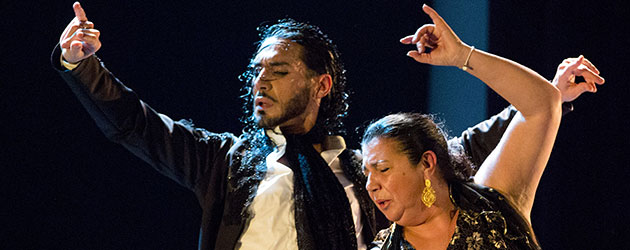Sara Arguijo
Photos: Remedios Malvarez
«Próxima parada, Sevilla». Dance: Carmen Ledesma and Amador Rojas. Voice: Antonio Campos and María Vizárraga. Piano: Ramón Santiago. Guitar: Eugenio Iglesias. Percussion: Luis Amador. Jueves Flamencos de Cajasol. Thursday, March 22nd, 2018
Carmen Ledesma goes sprinkling life with every step. Her body is in itself, a story of her own experiences, when she walks, she inevitably pulls along memories and emotions. As if in each one of the nails of her heels, all her triumphs and failure were affixed, and she remembered them in each step. In this way, she looks and you understand what she’s seeing. She takes aim, and you quickly know where she’s headed.
In a certain sense, what most draws you in about this dancer, is that what she does always expresses her way of being in the world. Practicing a kind of flamenco that is honest and consistent, that needs no filters of the sort we all like to use to conceal supposed imperfections at all costs. On the contrary, Ledesma rejects that sort of fake beauty, and yearns to find beauty in everything we have within reach. Which is why she dances to things that exist, and only seeks to reach that which she can hold with her own hands, without hesitation. Not out of conformity, but intelligence. “Iron lady” (gitana de hierro) as Campos sings to her in bulerías in one rush of genius.
As for Amador Rojas, he is a pompous dancer. His work is riddled with turns, effects and even circus-like pirouettes do aspire to the intangible. Opting at every moment more for the histrionic interpretation of the message, the fiction, than for the expressive route that makes an artist search within himself.
It’s true that like Ledesma, he is a very personal dancer, original in some ideas, and practically with a sort of freedom that today is seen all too seldom. But this time, it was too much. Perhaps because it’s hard for the spectator to get into two concepts of dance so different from one another, and having to deal with so many extraneous elements (chairs, shawls, singers getting up and sitting down, senseless lighting at times…).
